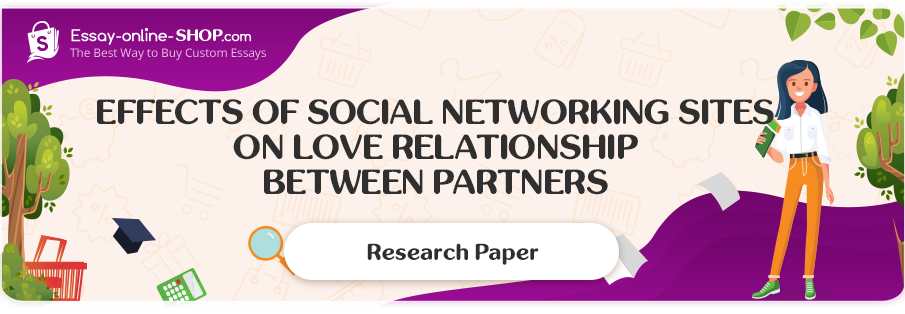
Operational definitions
Love relationships. This is co-operation and bonding between partners, that is, between boyfriends and girlfriends.
Literature review. It is an account of what has been published concerning the effect of social networking sites on family relationships.
Social networking sites. They are virtual communities where subscribers can create public profiles meet with other people and create new relationships
Social network addiction. This is excessive use of social media, so much so that it interferes with other aspects of life.
Negative consequences. These are undesirable outcomes following excessive use of social networking sites.
Abstract
The purpose of this study is to assess the effect of social networking sites on love relationship between partners. It will make use of the qualitative research as well as quantitative analysis. The aim is to collect a profound understanding of the behavioral deviations that the social networking sites cause as well as the reasons that govern such behavior. Questionnaires will be developed and administered to obtain data from the respondents. Data from the respondents will be analyzed by use of SPSS and Microsoft Excel.
Effects of Social Networking Sites on Love Relationship Among Partners
Social networking sites are virtual communities where subscribers create individual profiles, interact with friends and meet other people on the basis of shared interests. In the last five years, these sites have increased exponentially in usage and become ubiquitous, giving people a new way to interact with each other. The previous studies indicate that addiction to social networking sites on the internet may be a potential mental problem on some users. A study conducted by Thomas (2008) found that social networking sites are more addictive than alcohol and cigarettes. As a matter of fact, social networking activities and love relationship between partners are mutually exclusive; thus too much time on one means less time on the other.
Many people, especially the youth are so focused on immediate gratification that they have relocated their real world activities to the digital world. For example, if they want to play games with friends, Facebook has an application to facilitate that. While it is incredible to have one’s partner a click away, there are face to face interaction aspects that cannot be transferred to the digital world. Although social networks aim to create and maintain relationships, they do not achieve this goal. As a matter of fact, actual words constitute a negligible measure of everything that goes into conversing. There are other aspects that are crucial in a conversation, and, to a greater extent, a relationship. Facial expressions, body language, inflections and tone in one’s voice are only a few things that make conversation and, ultimately, interaction more meaningful in real life (Neelamalar, 2009).
The appeal of social networking sites is a potential cause for concern, particularly when addressing the increasing amounts of time that people spend online. Rather than becoming addicted to the medium, some people become addicted to other activities such as net compulsions and cyber relationship. However, cyber addiction falls to the latter category. Most people prefer online relationships to real life relationships. This is because through social networks, one can create an ideal persona of himself or herself to attract attention as opposed to real life situations. In light of this, many adolescents and their adult counterparts have shifted from real life love relationships to cyber relationships (June, 2011).
Literature Review
Anderson (2009) reveals that the number of social networks users has more than quadrupled in the past five years, from 6 per cent to 43 per cent in 2011. Although these sites facilitate sharing and social interaction, they often lead to unexpected alienation. The sites have largely replaced face-to-face human interaction. Additional to this, most people have become alienated from important social events as they take place in real time. The unceasing urge to share through social sites fundamentally divides the people who are experiencing and those who are documenting the event.
In a research conducted by Lawrence (2010), 25 percent of the participants to a survey revealed that they had missed out on love related events because they were too busy updating their status as well as communicating with people online. On the same vein, 23 percent of the respondents said that even if they attended social gatherings, they spent the better part of their time documenting their experiences in the gathering instead of enjoying the special moments. Many respondents admitted that they failed to enjoy special moments because they worried about angling for the right Instagram shot or composing the perfect tweet. Worldwide, people spend 10.5 billion minutes on Facebook each day, which is an equivalent of twenty years per day. A survey by Badoo reveals that 40 per cent of Americans spends more time on social networks than on physical interaction. 20 per cent of the respondents preferred communicating via text to face-to-face communication while a whopping third revealed that they were more likely to approach someone new online than offline.
Use of social media has been embraced across the globe and particularly in the developed countries. It has rapidly developed to a problem that affects the people, both young and old because most people prefer electronic communication to face-to-face communication. In light of this, it has become a huge problem that has weakened the fabrics that join friends in real life, and transformed physical relationships to virtual relationships. It is, therefore, imperative to determine the issues underlying the use of social networking (Brenda, 2009).
Demonstration of a Research Gap
Several researches have been carried out to determine the effect of social networks on love relationships. Though social networking has been a chronic disease manifested in reduction of social ties in real life, researchers have performed very few studies to investigate the effects on relationships. Therefore, it is imperative to determine the effects of social networking love relationships. However, it is evident in the literature that love relationships at the different parts of the world are not at their best. Yet, there is scanty information with regard to the effect of social networking on love relationship. It is in this respect that the current study intends to investigate the effects of social networking on physical relationship and actions that can be implemented to ameliorate the problem. The information gathered as well as the recommendations will go a long way in helping to diagnose the underlying circumstances and, subsequently, find a remedy.
Research hypotheses
Following the review of literature, it is clear that social networking has had an exponential growth in the past five years. This is, in part, because of the ease of access to computers and the Internet. A few internet users are able to balance use of social media and real life interaction while a great deal of internet users neglects real life relationships in favor of social networking relationships. This research will prove or disprove the following hypotheses:
Directional Hypothesis
Online social networking makes people less likely to be devoted to love relationships.
Null Hypothesis
Online social networking does not make people less or more likely to be devoted to love relationships.
These hypotheses will aid in investigating the effect of social networking on love relationships. Depending on the responses from the respondents, the researcher will test the hypotheses to find out which hypothesis is true. This will go a long way in determining the effect of social networking sites on love relationships between partners.
Method
Research Approach
This research will employ the qualitative research method through quantitative analysis to collect a profound understanding of the behavioral deviations that the social networking sites cause as well as the reasons that govern such behavior.
Sampling Method
The sample size is 90, and they are college students from the Department of Psychology, and of any age. Samples will be randomly selected from different class levels as long as they are active social networking sites users. The respondents (sample size) in the Department of Psychology will be selected using random sampling technique. Only the students present during data collection period will participate in the study.
- FREE revision (within 2 days)
- FREE title page
- FREE bibliography
- FREE outline (on request)
- FREE e-mail delivery
- FREE formatting
- Quality research and writing
- 24/7/365 Live support
- MA, BA, and PhD degree writers
- 100% Confidentiality
- No hidden charges
- No AI-written content
- Complete Authenticity
- 12 pt. Times New Roman
- Double-spaced/Single-spaced papers
- 1 inch margins
- Any citation style
- Up-to-date sources only
- Fully referenced papers
Research Methods
The research will make use of survey method. A survey will be conducted among randomly selected students from the Department of Psychology students who are active social site users from any age bracket. The surveys will be done using manual administration of the questionnaire to the respondents.
Study Design
The study will be conducted as a cross-sectional descriptive study. A cross-sectional study involves observation of a population representative at a point in time. Therefore, the respondents will be asked to give information at a point in time (without backward or forward timing).
Study Population
The study will cover the Psychology Department in the college. The study will target at the students in that department, and random sampling will be done. The study will involve randomly selected active social networking sites users in the Department of Psychology.
Study Variables
The independent variable is the social networking sites while the dependent variable is the interaction in real life. An independent variable represents the cause or the input, and it is tested to see their effect. On the other hand, a dependent variable represents the effect or output; it is tested to see if it is the effect.
Data Collection Procedure
In order to ensure that all relevant information that allows correlation as well as measurements is gathered, the researcher will make joint use of interview and questionnaires. Questionnaires will be developed and administered to obtain data from the respondents. The questionnaire for students will carry brief instructions on how they should respond to the questionnaires. The questionnaires will be comprised of three sections. Section A will elicit biographical data of the students; section B will capture information on the extent of use and effect of social networking sites on real life interactions. Section C will limit itself to views on strategies that should be put in place to ameliorate the problem. In interviews, information will be obtained through inquiry by research enumerators. Structured interviews will be performed using survey forms, and open interviews will be done by taking notes while talking with the respondents. The open-ended interview, which will be interpreted and analyzed during the interview, will be carried out by well trained enumerators to avoid errors. The researcher will also make use of available secondary data (from the Internet) to supplement the collected data.
Inclusion and Exclusion Criteria
Inclusion Criteria
Any student in the Department of Psychology who will be present during data collection period and will give an informed consent to participate in research will be included. The participants must be active users of social networking sites.
Exclusion Criteria
- Students in the Department of Psychology who refused to participate in the research.
- Students in the Department of Psychology who were absent during data collection.
Data Collection and Procedures
The researcher will obtain an introduction letter from the administration. He will then visit the research site that is the Department of Psychology to deliver the questionnaires. The researcher will obtain an informed consent from the students and explain to them how to respond to the questions and assist in case of difficulties. After completion, the researcher will thank the respondents for participating.
Data Management
The researcher will do data categorization and coding during preparation of questionnaires. The data collected will be coded and keyed into variables using SPSS (computer software) and Microsoft Excel. The researcher will then analyze the data using SPSS and Microsoft Excel.
Ethical Consideration
The researcher will obtain permission to conduct the research from the administration. The researcher will then obtain informed consent from the participants (students from the Department of Psychology) by explaining to them the purpose of the study and allowing them to give consent from informed point of view. Above and beyond this, the researcher will maintain confidentiality and respect throughout the research process.
You can ask us “write my research paper” on this or any other topic at Essay-Online-Shop.com. Don’t waste your time, order now!
Conclusion
The aim of this research is to present an overview of the effects of social networking sites on love relationship between partners. The social networking sites were defined as virtual communities that offer members the possibility to use the sharing media content. This study is anticipated to have various limitations. The principal limitation is the financial constraints. These constraints are related to typing, printing, travelling, training of enumerators as well as miscellaneous expenses. Considering that the researcher does not have funding, the entire exercise will be challenging. Another limitation of the study is that only questionnaires and interview will be used to collect the data. This is because of time limit as other methods of data collection require a considerable amount of time. While this study investigates the effect of social networking on love relationships, it does not cover an investigation into the solution. This leaves a gap for a future research which should capture the effects of social networking addiction, diagnosis, as well as the solution to the problem.






